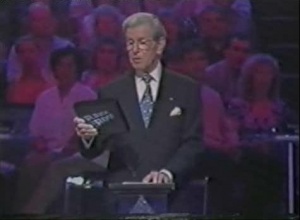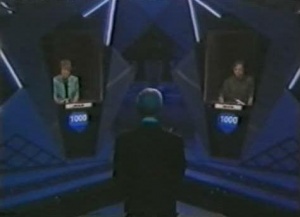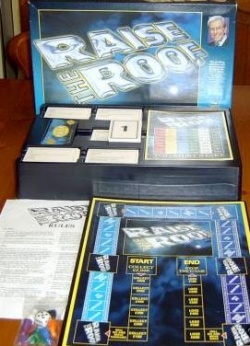Raise the Roof
(→Broadcast) |
(→See also) |
||
| Line 98: | Line 98: | ||
[[Weaver's Week 2012-01-15#Raise the Roof|Weaver's Week review]] (2012) | [[Weaver's Week 2012-01-15#Raise the Roof|Weaver's Week review]] (2012) | ||
| - | |||
[[Category:General Knowledge Quiz]] | [[Category:General Knowledge Quiz]] | ||
[[Category:Big Prize]] | [[Category:Big Prize]] | ||
| + | [[Category:Action Time Productions]] | ||
| + | [[Category:Yorkshire Television Productions]] | ||
Revision as of 22:33, 20 September 2012

Contents |
Host
Co-hosts
Announcer: Charles Foster
Broadcast
Action Time in association with Yorkshire for ITV, 2 September 1995 to 13 January 1996
Synopsis
Headline: Action Time give away a £100,000 house on the show every week and thus try to make all other "big prize" game shows in the UK completely redundant. Interesting idea, but can AT improve their track record with Raise The Roof? Or will this be yet another gimmicky quiz show except with a hyper-inflated prize?
Style
The visuals of the show certainly impress - big money hasn't just been spent on the prize but also on the set and the lighting. The set is classic in design, though it has a nice square-based pyramid which lifts up and down to reveal Bob the host and the various podiums swing in and out along well-defined lines on the studio in a very neat fashion. The lighting deserves special mention; there's lots of it and it's used well, with dramatic spotlights second only to those in the UK version of Gladiators.
Opening credits and all the graphics on the show are silver-grey on black with all letters and digits forming as if from mercury - quite similar to the effects in Terminator 2. The theme music is pseudo-classical and epic in style but very drawn-out. Once the titles are over, we are introduced to each of the six contestants, sat at a circular table with between one and four of their friends and/or relatives, as the spotlights converge on them pincer-like. Bob is revealed to be under the Raise The Roof roof (see picture), walks out and the pyramid disappears off-set.
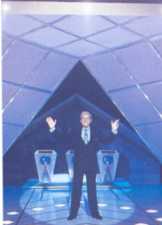 Host Bob Holness makes his grand entrance
Host Bob Holness makes his grand entranceGimmicks ahoy
Things start to go a little downhill from here. Bob describes the house that can be won, with a nice video. It's fully furnished and nicely situated. Two podiums (podia?) each accommodating three players roll on neatly, followed by contestants marching on in similar fashion to their appointed place. Bob introduces us to ERIC, the Electronic Random Inquisitor's Computer, a gadget that looks a bit like a Game Boy on which the questions and answers apparently appear. It's a leverless gizmo whose sole purpose is to do something different for the sake of doing something different than the traditional file cards. It doesn't inspire much confidence.
Lucky Seven
The first game consists of seven questions taken one at a time. Bob read statement out, contestants press a button with "True" or "False" on their podia (podiums?). In a nod-and-a-wink to Wipeout, a correct answer earns cash but an incorrect answer resets their score to zero. This is a little harsh if the first six questions are answered correctly and the seventh wrongly, bankrupting the contestant. The questions are of increasing value, something like 50-55-60-70-80-85-100 pounds, meaning total of £500 pounds going 7-for-7. The three contestants with the highest scores move on to the second round, the other three leave taking any cash they've got left, and a china teapot of a house referred to as "Bob's Bungalow". Ugh. All cash earned by contestants at the end of each segment is safe and cannot be lost under any circumstances.
Bid and Break
Round two sees the two sets of podia whisk off to the sides, and a new set of three for the victorious trio slide in from the back. Each contestant starts with £500 (regardless of how they finished the previous round - why?!?) and aims not to have the lowest amount left of the three at the end of the round. The round consists of six questions, each with Bob announcing the subject of the next question before the contestants announce how much money (from £1 to £100) they wish to wager.
Bob asks a question and the three contestants race to press their buzzers to answer correctly. If you buzz in first, you win your bet, but a wrong answer or being beaten by another player deducts the amount you bet from the score. The tactic seems to be use big bets to get a decent-sized lead, then use one pound bets to make sure that your score can't be eroded after that. It's vaguely interesting, but a bit slow and dull, really. The contestant with the lowest score after the sixth question leaves with the amount of cash remaining in this round, the amount accrued last round and that dratted bungalow teapot.
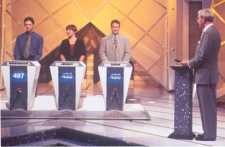 Bob Holness gets ready to ask the contestants for their bids in Bid and Break
Bob Holness gets ready to ask the contestants for their bids in Bid and BreakHome Run
The second half resumes with a sporting handshake between the two remaining contestants, while Twenty-One-style isolation booths slide on from the sides which the contestants subsequently enter. They can hear Bob but not each other. Each contestant's score is reset to £1000, and five questions follow in much the same way as the previous game. The only differences are that each player is allowed to offer an answer (no buzzers are used), and they can wager up to £200 per question (which they do by entering the values via a keypad - another seemingly pointless gimmick). Someone who bets the maximum each time (as many of the winners did) can double their £1000. The winner advances to the final, the loser picks up the money they have remaining and the amounts they won in the previous two rounds and a lovely teapot, blah blah blah. Typically even second place can pick up two-and-a-half grand, though, which isn't bad.
High Five
The final game starts promisingly with a cool effect. On the diamond-shaped patterns which form the set, 54 different questions categories appear (The Olympics, Romans, Africa, Soap Operas etc.) from which the finalist picks his best five. He has one minute's answering time to give correct responses to any four of the five. Bob will ask the questions in any order and doesn't object to skipping from one question to the next. The one minute is purely thinking time - while Bob is asking questions, the timer does not run down. An incorrect answer loses the game, so if Bob asks a question you don't know the answer to, you pass on it and answer the other four. Getting four correct answers in this way wins the house (and Bob announces that overall that evening the contestant has won £103,148 and 62p, or however much).
Easy, easy
It's all very nicely and neatly done.
Two main problems: it's all been done before, often better, and the questions are way, way too easy considering what prize is up for grabs. On the first show, the winning contestant got all 22 he was asked correct. My Dad got all 22 correct. My mate at work got all 22 correct. Considering what can be won and how much harder it was to win 6,400 pounds on the The 64,000 Dollar Question, the show is really let down by that fact. If the questions were really searching, perhaps just in the end game, then the show would have a real climax and be really quite good.
 Bob Holness raising a roof - subtle, no?
Bob Holness raising a roof - subtle, no?Early doors
As it is, though, nothing done wrongly, but not much done correctly. The show worked well enough but even in the USA you'd think it was just another quiz show. Bob hosted the show seriously, but slowly so that the show never really had much of a pace to it, despite his consummate professionalism. It only lasted for one series on ITV.
However, what is ironic is that Action Time were later "out-actiontimed" by an even bigger-budget (and rather more engaging) quiz, Celador Productions' Who Wants to be a Millionaire?
Inventor
Devised by Stephen Leahy and Andrew O'Connor.
Theme music
Composed by Mike Woolmans.
Trivia
Viewing figures were not good for the era - 6.1 million against 13.8 million for Casualty on BBC One.
Merchandise
A board game was produced.
See also
Weaver's Week review (2012)

